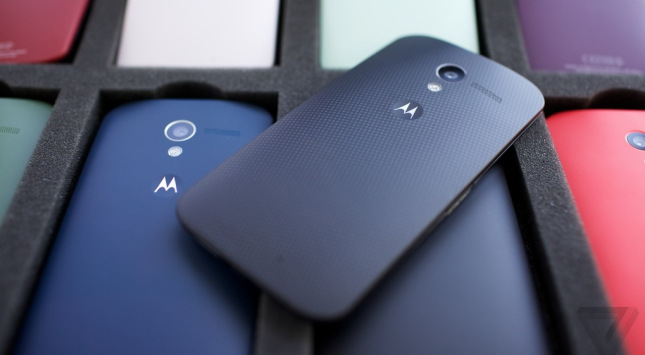 Need more evidence that smartphone prices are about to tank? Look no further than Lenovo’s announcement on Wednesday to buy Motorola from Google for $2.9 billion. While the deal gives the Chinese company its long desired presence in the Western smartphone market, it also represents a looming commoditization. The rule of thumb with Lenovo is: when the company comes knocking, your product is probably about to jump the shark, if it hasn’t already.
Need more evidence that smartphone prices are about to tank? Look no further than Lenovo’s announcement on Wednesday to buy Motorola from Google for $2.9 billion. While the deal gives the Chinese company its long desired presence in the Western smartphone market, it also represents a looming commoditization. The rule of thumb with Lenovo is: when the company comes knocking, your product is probably about to jump the shark, if it hasn’t already.
Lenovo’s most famous purchase came in 2004, when it announced it was buying IBM’s PC division and ThinkPad brand for $1.7 billion. PCs were already commodified by that point, with prices and profits going nowhere but down. IBM wisely saw the writing on the wall and got out while the getting was… well, not good, but at least doable.
The question everyone was asking was why would anyone want to buy a sinking ship? Lenovo’s executives had a simple answer: they wanted to become China’s first international brand. The profit margins on PCs were shrinking, but everybody still needed them, so what better way to familiarize the world with the Lenovo brand than with a ubiquitous product?
The plan worked. The PC market itself has gone straight down the toilet in the nine years since the acquisition, with 2013 seeing the worst decline in its history, but Lenovo emerged as the king of the whole stinky pile. It’s now the world’s top PC maker and pretty much a household brand, at least to people who buy computers.
IBM, happy to have a willing partner on which to unload its dregs, went back to the well again last week with a deal to sell its low-end server business to Lenovo for $2.3 billion. That market tanked a while ago so again, why would Lenovo want to get into it? For the same reason - people still want cheap servers and the company still wants exposure and brand recognition. It’s willing to take a small profit to do so, which is a simple business strategy: it’s sacrificing margins for market-share gains.
The Motorola purchase follows the same pattern. Regardless of what they cost, people will be buying smartphones for years to come - and probably at a faster clip than PCs, which is why this is perhaps the Chinese company’s best brand move yet. If the average Western consumer hasn’t heard of Lenovo by this point, they inevitably will over the next few years.
The most telling part of the deal is that Google will retain many of Motorola’s patents as well as its advanced research and development unit, which is too bad in a way because it probably means we won’t be seeing innovative phones like the Moto X from the new Lenovo-owned entity. If that doesn’t spell out the fact that the company will soon be selling a cheap, non-innovating commodity, nothing does.
Evidence of the bottom falling out of the smartphone market is mounting. Market leaders Apple and Samsung are seeing slowdowns while smartphone adoption leaders are experiencing shifts in customer buying habits. Australians, for example, are starting to shun long-term contracts in favour of shorter ones or buying their devices up front.
The looming commoditization is good news for consumers. As I’ve mentioned before, with the market jumping the shark the only natural way for prices to go is down. With declining prices, long-term contracts will make less sense, and without contracts to lock customers in, prices on monthly service will also inevitably go down.

Aaron
January 30, 2014 at 11:52 am
Not sure I can agree with that assessment. The reality of smartphone subsidies and long-term contracts means that the normal economic rules of consumer products don’t apply to smartphones. Since wireless carriers eat the majority of the cost of phones, there is less downward pressure on prices. The vast majority of consumers don’t buy their phones outright, and I have a hard time imagining that changing anytime soon.
Google has proven to be the only company interested in pushing down the cost of phones (through both the Nexus program and Motorola), as they make their money from advertising and want to get phones into the hands of as many people as possible. Lenovo wants to make a profit on hardware, and thus I can only see the cost of Motorola devices rising from here onwards. That leaves Nexus devices as the only affordable option for a consumer looking to purchase a phone outright for less than $600.
massive_cynic
January 31, 2014 at 6:18 pm
Wireless carriers do not eat the majority, or indeed _any_ of the cost of smartphones. Consumers surely pay _over_ 100% of the cost of our phones by the end of a given contract thanks to the carriers’ deceptive billing practices. I recently paid a $500 ETF to Bell after a little over a year into a 3 year sentence, for a phone that costs less than $300 all-in. Just because you can “buy” an iPhone for $200 from a carrier doesn’t mean the carrier pays the other $400+.
Phone Bill Ninjas (@PhoneBillNinjas)
February 2, 2014 at 3:34 pm
I do think that phones like the Nexus 5 and Moto G, which are available at a relatively low cost, are going to cause a lot more people buy their phones outright. In turn, these customers are going to demand that carriers offer them better pricing for BYOD which I feel (hope) will drive down the cost of plans. Perhaps carriers will get into the business of providing wireless service vs. financing phones.